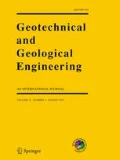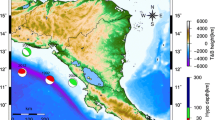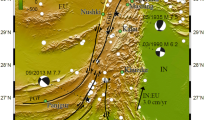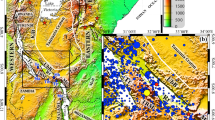Abstract
We estimate the maximum magnitude scaling relationships for strike-slip earthquakes in Myanmar based on the well-investigated coseismic fault rupture of two earthquake events in Myanmar: the 2011 Tarlay and 2012 Thabeikkyin earthquakes. We compare the relationship between the model parameters of the two earthquakes, namely the fault rupture areas (A), length (L), and slip rate (S), calculated using empirical scaling laws models with the estimated earthquake magnitude. The different maximum magnitudes resulting from the empirical scaling models suggest that using a proper scaling relationship is very important for estimating the maximum magnitude for strike-slip faults in Myanmar. This study demonstrates that earthquake magnitude from strike-slip faults in Myanmar is controlled by the fault rupture length and slip rate.





Similar content being viewed by others
References
Alam M, Alam MM, Curray JR, Chowdhury MLR, Gani MR (2003) An overview of the sedimentary geology of the Bengal Basin in relation to the regional tectonic framework and basin-fill history. Sediment Geol 155(3–4):179–208
Anderson JG, Wesnousky SG, Stirling MW (1996) Earthquake size as a function of fault slip rate. Bull Seismol Soc Am 86(3):683–690
Bird P (2003) An updated digital model of plate boundaries. Geochem Geophys Geosyst. https://doi.org/10.1029/2001GC000252
Cummins PR (2007) The potential for giant tsunamigenic earthquakes in the northern Bay of Bengal. Nature 449(7158):75
Gunawan E, Widiyantoro S (2019) Active tectonic deformation in Java, Indonesia inferred from a GPS-derived strain rate. J Geodyn 123:49–54. https://doi.org/10.1016/j.jog.2019.01.004
Gunawan E, Sagiya T, Ito T, Kimata F, Tabei T, Ohta Y, Meilano I, Abidin HZ, Agustan, Nurdin I, Sugiyanto D (2014) A comprehensive model of postseismic deformation of the 2004 Sumatra-Andaman earthquake deduced from GPS observations in northern Sumatra. J Asian Earth Sci 88:218–229. https://doi.org/10.1016/j.jseaes.2014.03.016
Gunawan E, Widiyantoro S, Rosalia S, Daryono, Meilano I, Supendi P, Ito T, Tabei T, Kimata F, Ohta Y, Ismail N (2018) Coseismic slip distribution of the 2 July 2013 M w 6.1 Aceh, Indonesia, earthquake and its tectonic implications. Bull Seismol Soc Am 108(4):1918–1928. https://doi.org/10.1785/0120180035
Gunawan E, Widiyantoro S, Zulfakriza MI, Pratama C (2019) Postseismic deformation following the 2 July 2013 Mw 6.1 Aceh, Indonesia, earthquake estimated using GPS data. J Asian Earth Sci. https://doi.org/10.1016/j.jseaes.2019.03.020
Hanks TC, Bakun WH (2002) A bilinear source-scaling model for M-log A observations of continental earthquakes. Bull Seismol Soc Am 92(5):1841–1846
Ischuk A, Bjerrum LW, Kamchybekov M, Abdrakhmatov K, Lindholm C (2018) Probabilistic seismic hazard assessment for the area of Kyrgyzstan, Tajikistan, and Eastern Uzbekistan, Central Asia. Bull Seismol Soc Am 108(1):130–144
Kanamori H, Anderson DL (1975) Theoretical basis of some empirical relations in seismology. Bull Seismol Soc Am 65(5):1073–1095
Khin K, Zaw K, Aung LT (2017) Geological and tectonic evolution of the Indo-Myanmar Ranges (IMR) in the Myanmar region. Geol Soc London Memoirs 48(1):65–79
Konstantinou KI (2014) Moment magnitude–rupture area scaling and stress-drop variations for earthquakes in the Mediterranean region. Bull Seismol Soc Am 104(5):2378–2386
Leonard M (2014) Self-consistent earthquake fault-scaling relations: update and extension to stable continental strike-slip faults. Bull Seismol Soc Am 104(6):2953–2965
Mai PM, Beroza GC (2000) Source scaling properties from finite-fault-rupture models. Bull Seismol Soc Am 90(3):604–615
Mallick R, Lindsey EO, Feng L, Hubbard J, Banerjee P, Hill EM (2019) Active convergence of the India-Burma-Sunda plates revealed by a new continuous GPS network. J Geophys Res Solid Earth 124(3):3155–3171. https://doi.org/10.1029/2018JB016480
Maurin T, Masson F, Rangin C, Min UT, Collard P (2010) First global positioning system results in northern Myanmar: constant and localized slip rate along the Sagaing fault. Geology 38(7):591–594
Metcalfe I (1996) Pre-cretaceous evolution of SE Asian terranes. Geol Soc London Spec Publ 106(1):97–122
Pailoplee S, Sugiyama Y, Charusiri P (2009) Deterministic and probabilistic seismic hazard analyses in Thailand and adjacent areas using active fault data. Earth Planets Space 61(12):1313–1325
Panda D, Kundu B, Gahalaut VK, Rangin C (2018) Crustal deformation, spatial distribution of earthquakes and along strike segmentation of the Sagaing Fault, Myanmar. J Asian Earth Sci 166:89–94
Satake K, Aung TT, Sawai Y, Okamura Y, Win KS, Swe W, Swe C, Swe TL, Tun ST, Soe MM, Oo TZ (2006) Tsunami heights and damage along the Myanmar coast from the December 2004 Sumatra-Andaman earthquake. Earth Planets Space 58(2):243–252
Shiddiqi HA, Tun PP, Kyaw TL, Ottemöller L (2018) Source Study of the 24 August 2016 M w 6.8 Chauk, Myanmar, Earthquake. Seismol Res Lett 89(5):1773–1785
Sloan RA, Elliott JR, Searle MP, Morley CK (2017) Active tectonics of Myanmar and the Andaman Sea. Geol Soc London Memoirs 48(1):19–52
Soe M, Takashima I, Zaw K, Swe YM (2017) Remote sensing and GIS studies of alteration and predictive mineral exploration in the Central Volcanic Arc, Myanmar. Geol Soc London Memoirs 48(1):473–496
Sun J, Shen ZK, Bürgmann R, Xu X (2013) Coseismic slip distribution of the 24 March 2011 Tarlay (Myanmar) M w 6.8 Earthquake from ALOS PALSAR Interferometry. Bull Seismol Soc Am 103(5):2928–2936
Thingbaijam KKS, Martin Mai P, Goda K (2017) New empirical earthquake source-scaling laws. Bull Seismol Soc Am 107(5):2225–2246
Tun ST, Watkinson IM (2017) The sagaing fault, Myanmar. Geol Soc London Memoirs 48(1):413–441
Wang Y, Sieh K, Aung T, Min S, Khaing SN, Tun ST (2011) Earthquakes and slip rate of the southern Sagaing fault: insights from an offset ancient fort wall, lower Burma (Myanmar). Geophys J Int 185(1):49–64
Wang Y, Sieh K, Tun ST, Lai KY, Myint T (2014) Active tectonics and earthquake potential of the Myanmar region. J Geophys Res Solid Earth 119(4):3767–3822
Wells DL, Coppersmith KJ (1994) New empirical relationships among magnitude, rupture length, rupture width, rupture area, and surface displacement. Bull Seismol Soc Am 84(4):974–1002
Wessel P, Smith WH (1998) New, improved version of Generic Mapping Tools released. EOS Trans Am Geophys Union 79(47):579
Zaw K, Swe W, Barber AJ, Crow MJ, Nwe YY (2017) Introduction to the geology of Myanmar. Geol Soc London Memoirs 48(1):1–17
Acknowledgements
We are very grateful to two anonymous reviewers for their thoughtful reviews, which substantially improved the manuscript. RH would like to thank the AUN/SEED-Net Project for a Doctoral Fellowship (2015–2018) for the support of research studies at Bandung Institute of Technology, Indonesia. EG was supported by the 2019 A-Category Research Fund of the Bandung Institute of Technology No. 0109/I1.B04/PL/2019. The figures were produced using generic mapping tools (Wessel and Smith 1998).
Author information
Authors and Affiliations
Corresponding author
Additional information
Publisher's Note
Springer Nature remains neutral with regard to jurisdictional claims in published maps and institutional affiliations.
Rights and permissions
About this article
Cite this article
Hlaing, R., Gunawan, E., Widiyantoro, S. et al. Assessment of the Maximum Magnitude of Strike-Slip Faults in Myanmar. Geotech Geol Eng 37, 5113–5122 (2019). https://doi.org/10.1007/s10706-019-00965-3
Received:
Accepted:
Published:
Issue Date:
DOI: https://doi.org/10.1007/s10706-019-00965-3




